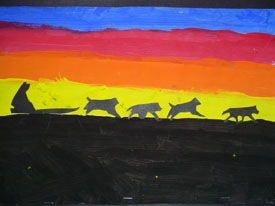|

February 24, 2008
While I’m holding my breath waiting for the captive-tiger debate to start, I’d like to point you to two more places where traditional Arctic life is making a complicated, often ironic interface with the twenty-first century.
One is the attempt to restore dogsledding, or mushing, by teaching the ancient practice back to a younger generation in love with snowmobiles. In fact, you could now make a case that it’s not snow that “Eskimos” (wrongly so-called) have twenty-eight or fifty words for—it’s snowmobiles:
Inuit life now is not like it was in the past, when the people lived on the land seven days a week. Many modern Inuit families work five days a week and go camping on weekends. To get to the good hunting or fishing places, some families travel between two and five hours by snowmobile. When some hunters were asked if they might be interested in starting a dog team, they simply replied, "Too slow." The Inuit are extremely practical. So, when they need to get from point A to point B in a short time, they choose to use a snowmobile. . . .
So instead of dog teams, [our youth] are obsessed with snowmobiles. . . . Students talk about snowmobiles, write about snowmobiles, draw meticulous pictures of snowmobiles, and look up snowmobiles on the internet. Even at a young age, they know the engine size, the track length and countless other details about a variety of snowmobile brands. As students get older, they become very proficient at repairing snowmobiles as well. Some can tear down an entire machine and put it back together with no formal training. Snowmobiling has become the culture of today’s Inuit.
Although the effort to revive “a culture of mushers” stems partly from the wish to preserve a remarkable skill and a centerpiece of cultural identity, it is driven at least as much by new practical concerns, which have made that wish less quixotic and nostalgic. As the sea ice becomes softer and thinner at times of year when Arctic dwellers rely on it for travel (as documented in Shari Gearheard’s “A Change in the Weather,” NH 2/2008), lives have been lost when heavy snowmobiles broke through the ice and sank. Dogs and dogsleds distribute a lighter weight over a broader surface—and dogs have senses and instincts for danger, as snowmobiles do not.
Inuksuit (singular inuksuk, “to act in the capacity of a human being”) are cairns or markers that native Arctic travelers built by piling up unshaped stones in a variety of forms. It’s impossible for us lower-forty-eighters, temperate-zoners, inhabitants of a mostly man-made environment, to imagine how Arctic dwellers saw the vast white world they lived in, which seems to us inimical, featureless, and inhuman. But the inuksuit, especially the human-shaped ones called inunnguat (singular inunnguaq, “an imitation of a person”), reach out to our imagination and give hints.
For one thing, they served the universal function of road signs—“here’s the trail,” “this way to good seal hunting,” “Eat at Joe’s” (a buried, frozen cache), “danger, thin ice”—as well as bulletin boards, the equivalent of graffiti tags [pdf] (“just as people in the south sometimes scrawl ‘Kilroy was here’”), and decoys to turn fleeing caribou herds. But they could also be gravestones, markers of memorable events, gateways to the sacred, and what we might imprecisely call altars or prayers. To us, it seems that an inunnguaq looming up out of a snowstorm must have been both an eerie and a welcoming sight, humanizing the elements and acting as a kind of missing link between the forbidding landscape and the people who called it home.
Inuksuit so capture the outsider’s imagination that as they have slowly lost their ancient functions they have gained new ones (see the “graffiti tags” link above)—as symbols of Canada’s Arctic north, and particularly on the flag of its newest, predominantly Inuit province, Nunavut; and as kitschy souvenirs, T-shirt icons, and collectible art.


(Annie Gottlieb) |
Comments (add yours!)

Return to February home
|


